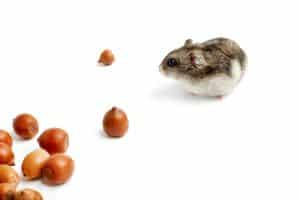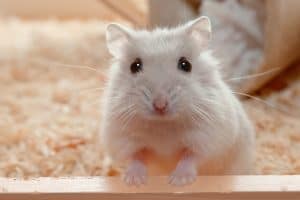We all want the best for our furry friends, and a happy, healthy living space is the first step in assuring a contented life for our pets. But where to begin? When obtaining a new hamster, your buddy itself will be fairly inexpensive, but you must consider the cost involved in creating their habitat. How do you set up a hamster cage? We've done some research and have the best information for you.
To set up a hamster cage, you'll need the following items:
- A big cage with a solid floor
- The perfect spot to put the cage in your home
- Substrate/bedding to line the bottom of the cage
- Water bottle
- Food Bowl
- Hamster house
- Chew toys
- Stimulating toys
- Hamster wheel and ball
- A Sand bath
So now that we've established the items you'll need to create the best home for your hamster, read on to find out all the details. Hamsters can easily get bored or stressed, so finding out as much as possible can give your hamster the best shot at a long and full life.
![brown hamster in cage nibbling on to sunflower seeds, how to set up a hamster cage p10 must have items]](https://hamsters101.com/wp-content/uploads/2020/11/brown-hamster-in-cage-nibbling-on-to-sunflower-seeds-How-To-Set-Up-A-Hamster-Cage-10-Must-Have-Items.jpg)
A Big Cage with a Solid Floor
The first thing you need is a cage for your hamster. And when it comes to hamster cages, bigger is better. In the wild, hamsters run for many miles, and they really do need a lot of space to be happy. Most of the pet store cages you find will be rather small, so consider getting a cage made for a larger animal instead of the one they market for hamsters. We recommend the cage be at least 450 square inches.
The bottom needs to have a solid floor as well, as seen in the linked product above. Hamsters are burrowers, so they will reach the very bottom of the cage at some point, so it needs to be solid and spacious.
The Perfect Spot
The place you set your hamster's cage is just as important as the cage itself. Hamsters can get anxious, so ensure your pet's cage isn't in a place with frequent loud noises or lights going on or off. It's imperative the hamster not be kept close to the heating or air ducts either, as extreme temperatures could also upset your pet. In the same vein, do not put your hamster in direct sunlight. Indirect light is great, but direct sunlight could be dangerous to the hamster's health.
Substrate/Bedding
To line the bottom of the hamster's cage, you'll need an appropriate substrate. The best, most popular substrate is wood shavings. The type of wood used definitely needs to be closely considered. Aspen is the best type of wood to use for your hamster's cage as it is hypoallergenic and scentless and will not harm your hamster. Plus, it is absorbent. Other types of wood substrate are available; however, it could make your hamster feel unwell due to its strong sense of smell. Try not to use cedar or pine as they have a strong scent. You'll need to always have substrate on hand and change it often as it becomes soiled by your hamster.
Try to keep 6 inches of substrate in your hamster's cage, so your fuzzy friend has plenty of space to burrow and hide. This ensures your pet feels safe and remains stress-free.
View this Aspen bedding on Amazon.
In addition to the substrate, you'll need to put additional material for bedding in your hamster's cage. This can just be shredded paper towels, tissue, or toilet paper. Your hamster will use this separate material to build its nest.
For more information, read our post, "How Much Bedding Does a Hamster Need?"
Water Bottle
A gravity-fed water bottle attached to the side of the hamster's cage is a necessity. You have the option of just using a water bowl, but a gravity-fed water bowl keeps the water free of the detritus in the cage. Not only does it need less cleaning, but it also doesn't need to be filled as frequently.
View this water bottle on Amazon
Food Bowl/Dish
Hamsters need to eat! You'll need to ensure your hamster has an ample food bowl to support various foods, not just the daily hamster food. Ensure your furry friend can easily get in and out of the food bowl; also, you don't want a bowl so large that it takes up a lot of your hamster's activity space. Keep this bowl free of contaminants and clean it consistently.
View this food dish on Amazon.
Read about some healthy foods to give your hamster in our post, "Can Hamsters Eat Celery?"
Hamster House
Your hamster will want a place to hide and store food, so a structure needs to be added to its cage. Ensure the hamster house you get is large enough to house your hamster, its potential nest, and its hoarded treasures. As with the food bowl, make sure the house you get is in good proportion to the cage and doesn't take up too much space.
View this hamster house on Amazon.
Chew Toys
Your hamster's teeth can grow very long if they don't have things with some resistance on which to chew. Ensure your buddy always has something to gnaw and chew upon to keep those long teeth filed down.
View these hamster chew toys on Amazon
Stimulating Toys
Outside of chew toys, hamsters need many stimulating toys in their cage. Hamsters love to climb, dig, and play hide and seek type games with their toys. You might have to try different types of toys to find your hamster's favorite! Just about all hamsters love tubes but remember, if you get tubes to make sure your hamster can comfortably move in and out of them.
View these hamster toys on Amazon.
Hamster Wheel and Ball
Hamsters need lots of exercise. In their natural habitat, they move and run all day. To simulate a large environment, you'll need to add a hamster wheel to their cage. Hamster wheels come in different sizes, so the one you purchase must be appropriately sized for your hamster. To know if it is large enough, observe your hamster as they run on it. If their back is arched as they run, you need a larger wheel. It is a great joy to watch them run on their hamster wheels!
View this hamster wheel on Amazon.
Also, considering getting a hamster ball for exercise. The hamster ball allows you to remove the hamster from the cage, place it inside the ball, and let it run around your home. This isn't necessarily a part of your cage setup but is worth mentioning and adding to the "hamster supply" list.
View this hamster ball on Amazon.
A Sand Bath
Your hamster will get dirty, and hamsters don't like water. Hamsters give themselves baths in the wild with sand or dirt. So your hamster can stay clean, consider adding a sand bath as a permanent fixture to your hamster's cage. If you'd prefer (or if you're running low on space), you can place the sand bath in the cage every few days, or perhaps weekly, so your hamster can bathe.
View this bathing dust on Amazon.
How Soon Can You Put a Hamster in a New Cage?
Once you have all the implements in place in your hamster's new cage, it's time to place your hamster in its new home. There is no waiting period or a timeframe to let things set. Unless you have reason to believe the cage or its contents have been contaminated, feel free to move your furry friend into its new house.
If this is a lateral move from one cage to another, try to incorporate some of its old toys, hideouts, or bedding into the new cage so it won't be brand new territory.

How Long Does it Take For a Hamster to Get Used to a New Cage?
A hamster should take at most about two weeks to adjust to its new cage. Some hamsters adapt faster, but just about all will be enjoying their new habitat within that timeframe. If your hamster seems stressed in the new environment, try speaking to it soothingly, and ensure the area its cage is in remains quiet and calm.
What Should You Not Put in a Hamster Cage?
You should not use newspaper or any paper with ink on it for a hamster cage. Additionally, avoid fluffy bedding like cotton balls, as this can cause your hamster to choke. As mentioned above, do not use cedar or pine bedding as your hamster's sense of smell is very sensitive.
In Closing
Setting up your hamster's cage is vital in ensuring a mellow, happy pet. Give your friend a safe place to play and live out their days. By following the steps listed above, you're sure to provide your little buddy with a full, healthy life.














Keep in mind hamster balls aren’t safe, they have poor ventilation , you may think your hamster likes it but they have no choice to run. Also, do not use sand that is labeled as dust, dust can cause respiratory problems and infections.